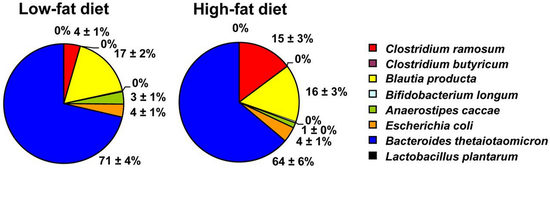Metabolic disorders associated with the human gut microbiota
Obesity is one of the foremost serious health problems in the United States and with a long list of causations and associate conditions; it is crucial to identify influencing factors. More and more research is being directed towards the affects of the complex system of microbes that live in the guts of all humans and the potential effects of specific bacteria on metabolic pathways. There have been many correlations drawn between the composition of individuals’ gut microbiota and conditions such as Fatty Liver Disease and Steatohepatitis both directly related with obesity, however there has only recently (ie. 2014) been growing research done on what specific genus and species of bacteria are involved in the complex symbiotic pathways that lead to the development of these metabolic disorders. Bacteria in the phylogenetic classes [2] and [3] have been shown to be directly correlated to metabolic disorders 1.
Function of Gut Microbiota in Animals
It is thought that microbes and animals developed symbiotically over evolutionary time, specifically microbes found in the digestive systems of animals that produced valuable metabolites for the animal. It is through this interaction that we see microbes found in the gut of animals are inherently linked to that animal's metabolic systems 6. Due to this linkage there is a direct correlation between any observed metabolic phenotypes in animals and the bacteria that are present in that animal's gut.
Metabolic Disorder:
Non-Alcoholic Fatty Liver Disease
There is currently a great deal of research being dedicated to understanding the exact ways that animal metabolic disorders are connected to the human gut microbiota "Fatty Liver Disease (FLD)" and in its latter and more dangerous phase Steatohepatitis have been linked to the presence and levels of specific classes of bacteria, Ersipelotrichi and Gammaproteobacteria, naturally found in the human microbiota 1. These classes of bacteria have been correlated with choline deficiency, an essential compound in lipid transport and storage in the body. Further research has shown correlation to bacteria found in the microbiota of a specific mouse strain to choline deficiency in via the chemical conversion of choline into methylamines then excreted by the body. Clostridium a genus in the class Ersipelotrichi, is associated with obesity and other metabolic disorders in humans, and was found to be linked with fat deposition in mice as opposed to its metabolization 3 and potentially plays a role in causing choline deficiency. Additionally in humans individuals with NAFLD were found to have higher levels of the genus clostridium and lower levels of Bacteroidetes, a class of bacteria that make up a significant portion of the human gut microbiota and help to regulate proper digestive function 8.

Potential Treatments
A chinese case study in rats 4 showed that regular treatment of rats with an ancient chinese herbal formula was affective in alleviating symptoms of fatty liver disease correlating to a decrease in the presence of bacterial genera Shigella and Escherichia both members of the phenotypic class Erysipelotrichi 4. An Eastern European case study also found a correlation between treatment of Clostridium genera with a variety of essential oils 5.
References
1 [Spencer, M D (03/2011). "Association between composition of the human gastrointestinal microbiome and development of fatty liver with choline deficiency". Gastroenterology (New York, N.Y. 1943) (0016-5085), 140 (3), p. 976.]
2 [Dumas M-E, Barton RH, Toye A, et al. Metabolic profiling reveals a contribution of gut microbiota to fatty liver phenotype in insulin-resistant mice. Proceedings of the National Academy of Sciences of the United States of America. 2006;103(33):12511-12516. doi:10.1073/pnas.0601056103.]
3 Woting A, Pfeiffer N, Loh G, Klaus S, Blaut M. 2014. Clostridium ramosum promotes high-fat diet-induced obesity in gnotobiotic mouse models. mBio 5(5):e01530-14. doi:10.1128/mBio.01530-14.
4 [Yin, X (05/2013). "Structural changes of gut microbiota in a rat non-alcoholic fatty liver disease model treated with a Chinese herbal formula". Systematic and applied microbiology (0723-2020), 36 (3), p. 188.]
5 Kačániová, Miroslava, et al. "Antibacterial activity against Clostridium genus and antiradical activity of the essential oils from different origin." Journal of Environmental Science and Health, Part B 49.7 (2014): 505-512.
6 [T. Hosokawa, Y. Kikuchi, N. Nikoh, M. Shimada, T. Fukatsu, Strict host-symbiont cospeciation and reductive genome evolution in insect gut bacteria. PLoS Biol. 4, e337 (2006).]
7 [Nicholsom, Jeremy K. et al. June 2012. "Host-Gut Microbiota Metabolic Interactions". Science. 336 (6086), 1262-1267.]
8 [Mouzaki, M., Comelli, E. M., Arendt, B. M., Bonengel, J., Fung, S. K., Fischer, S. E., McGilvray, I. D. and Allard, J. P. (2013), Intestinal microbiota in patients with nonalcoholic fatty liver disease. Hepatology, 58: 120–127. doi: 10.1002/hep.26319]
Edited by Sam DeRosa, a student of in BIOL187S (Microbiology) in The Keck Science Department of the Claremont Colleges Spring 2015
